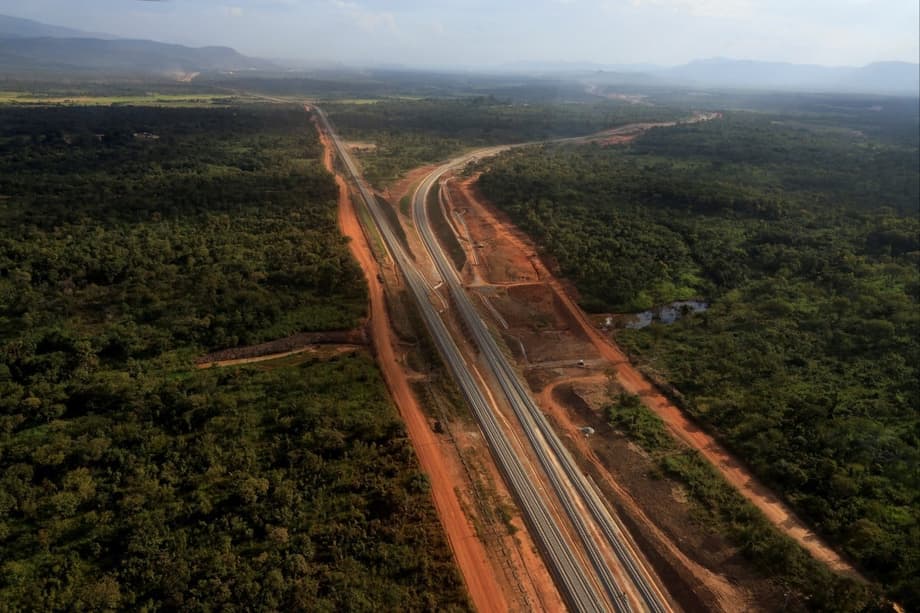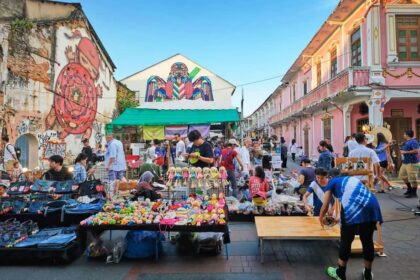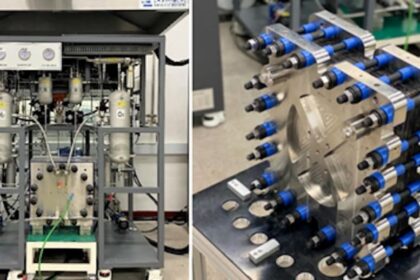A logistics dispute at a turning point for Simandou
Guinea is marking the first loads of iron ore from the Simandou project, a 20 billion dollar mine, rail, and port complex that could reshape global iron ore supply. The celebration coincided with a procurement clash that spilled into public view. In September, Guinean authorities turned back a shipment of 18 Chinese built locomotives at the Port of Conakry, citing a binding requirement in the project framework that trains for the corridor must be sourced from the United States. The episode unfolded as the new railway and port neared commissioning and as early cargoes began to move from the Morebaya export hub. The debut shipment is symbolic, but the plan calls for very large volumes once operations stabilize.
Most Simandou ore is expected to flow to China, where state owned and private companies are core investors across the venture. The rejection of Chinese locomotives, intended for Winning Consortium Simandou (WCS), underscored how Guinea is enforcing the co development agreement that governs the shared rail and port. The locomotives were returned to China. WCS had already placed an order with Wabtec in the United States for heavy haul units scheduled to arrive from October 2025, aligning with the agreement. The timeline created pressure to introduce rolling stock early, but the government drew a clear line around procurement rules.
A senior Guinean official involved in project oversight said the decision was about contract compliance, not about singling out one country. The person requested anonymity to discuss a sensitive commercial matter.
The measure was not about targeting Chinese locomotives. If they had brought in a locomotive made by any other country, we would have made the same decision to cancel the contract.
The statement came as the joint venture behind the rail and port, La Compagnie du TransGuinéen (CTG), continued to receive United States designed Wabtec locomotives assembled in India for the Simfer side of the project. Four units arrived in October, with dozens more to follow for both Simfer and WCS under existing contracts.
What is at stake with Simandou
Simandou contains one of the largest untapped iron ore deposits on the planet. Estimates put reserves at well above 3 billion tons. The ore is high grade, around 65 percent iron content, which is prized by steel mills that want to cut emissions and reduce coke use. The mine and its 650 to 670 kilometer Trans Guinean Railway, plus a deep water export hub at Morebaya near Forecariah, form an integrated network that can move as much as 120 million metric tons a year at full ramp up. The International Monetary Fund estimates the project could lift Guinea gross domestic product by about 26 percent by 2030, a scale rarely seen for a single investment in West Africa.
China is both a financier and the likely destination for much of the ore. State owned China Baowu Steel Group, Chinalco through Chalco Iron Ore Holdings, and WCS, a partnership of Winning International and China Hongqiao Group, are embedded across the project. The attendance of China Vice Premier Liu Guozhong at the commissioning ceremony underlined Beijing interest in securing premium supply for a greener steel process.
The launch phase is already visible at Morebaya. Two ships arrived in early November as Guinea readied the logistics chain. Operators unveiled the first wave of locomotives and thousands of ore wagons are slated to arrive, each designed to carry about 81 tons. Early cargoes leave by barge for transshipment to larger bulk carriers offshore. WCS said a barge loaded with about 9,850 tons left the new port and met its carrier Winning Youth at sea.
Who owns what
Simandou is split into four blocks. Blocks 1 and 2 are run by WCS. Blocks 3 and 4 are developed by Simfer, a joint venture of Rio Tinto, the government of Guinea and Chalco Iron Ore Holdings. The rail and port are held in CTG, which is owned 42.5 percent by Simfer, 42.5 percent by WCS and 15 percent by the state. After a 35 year operating period the infrastructure will transfer to Guinea.
Locomotive procurement reflects this architecture. Rio Tinto SimFer placed a 277 million dollar order in 2024 for 78 Wabtec Evolution Series locomotives for CTG, while WCS signed a separate 248 million dollar contract for 65 more of the same platform in January. Wabtec builds these units at its Marhowra plant in India with engines designed in the United States.
How a procurement rule triggered a diplomatic tangle
The shipment of 18 Chinese built locomotives that arrived at the Port of Conakry in September was intended to accelerate the rail ramp up for WCS. Guinean officials blocked their entry, citing a project term that requires United States locomotives for the CTG network. The units were reloaded and shipped back.
Project managers had to square tight deadlines, a complex multi party governance, and national content or partner commitments. Standardizing the locomotive fleet under a single manufacturer simplifies maintenance, training and parts. It also aligns with terms negotiated with partners and lenders. Guinea leaders have also signaled a desire to balance global partners while retaining the final say on strategic assets.
Chris Aitchison, managing director of Rio Tinto SimFer, called the arrival of the first Wabtec locomotives a landmark for the railway and the country. He highlighted the role of the Trans Guinean line in connecting communities and opening new trade.
The locomotives are a visible sign of the progress being made and the future benefits the Trans Guinean railway will bring by connecting communities, enabling trade, and supporting sustainable development across the country.
The fast pace of delivery reflects a shared aim to move ore in the near term while locking in the long term structure of the corridor. For Guinea, the rule on locomotives sets a template for other sensitive procurement decisions, while the heavy participation of Chinese groups in construction and mining continues.
From the presidential palace, Djiba Diakité, minister and chief of staff to the president and head of the Simandou 2040 committee, framed the launch as a national project.
Simandou is more than a mining project. It is the driving force behind a national transformation.
That framing helps explain why Conakry is strict on project terms. The railway and port are intended for multi use, including passenger and general freight service, not just iron ore trains. Policy makers want a system that is reliable and serviceable for decades.
Why the rail and port matter
The Simandou deposit sits deep in the mountainous southeast. Decades of delay came down to infrastructure. Moving hundreds of millions of tons of ore to the Atlantic coast requires a new corridor across river valleys and hills. The Trans Guinean Railway, about 650 to 670 kilometers long, is the spine of that corridor. The line links the mining hubs to Morebaya, a new port complex designed with barge operations and offshore transshipment to large bulk carriers.
The network is designed for more than ore. Guinea plans to run passenger trains and general freight on the same alignment, a potential boost for inland towns. The decision to build a double track line raises capacity and helps avoid bottlenecks as Simfer and WCS trains share the route. CTG will operate the corridor under a long concession before handing it to the state.
Port choices also reflect the topography. The initial steps use barges to carry ore down the channel to deep water where bulk carriers wait. This approach allows exports to begin while permanent shiploader systems and breakwaters reach completion. It carries risks in bad weather, but it also accelerates first revenue.
Ramp up timeline
A full ramp up to 120 million metric tons a year will take time. Early shipments are small. Operators will progressively add trains, wagons, and loading infrastructure. The arrival of thousands of wagons and scores of locomotives through 2026 and 2027 will lift volumes. Parallel work on signaling, passing loops, and maintenance depots will determine how fast the line can safely push large consists to the coast.
Guinea expects the corridor to support broader commerce as capacity grows. That means new market access for farmers and traders along the route, and an incentive to develop industrial zones near stations. Authorities will still need to manage resettlement, biodiversity, and safety in forested terrain where rivers and protected habitats require careful planning.
What this means for iron ore and steel
For the global iron ore market, Simandou introduces a large new stream of high grade supply. The shift could reduce the leverage of current giants in Australia and Brazil and create more choice for Asian mills. Chinese buyers in particular are seeking to cut blast furnace emissions. High iron content reduces the amount of coke required per ton of hot metal and boosts output from direct reduction plants that use natural gas or hydrogen.
Price effects will depend on timing and reliability. The market can absorb new supply if global steel demand grows or if higher grade ore displaces lower grade brands. Producers have faced volatile prices in recent years, with cycles driven by China construction and stimulus policy. Simandou shipments will start small, then scale, giving traders time to adjust contract mixes.
For Guinea, the bigger prize is steady fiscal revenue and infrastructure that outlasts the mine. Stable rail service can lower logistics costs for domestic commerce. The ore levy and royalties can fund health, education and power projects. The spotlight also brings scrutiny on governance, transparency, and community benefits, areas where the government has pledged to meet international standards.
Reactions from Beijing, Conakry and industry
At the launch ceremony, China Vice Premier Liu Guozhong cast the project as a milestone of China Guinea cooperation that stretches back decades.
This project is the result of nearly 70 years of friendship and cooperation. It will contribute to Guinea economic development and the implementation of its Simandou 2040 strategy.
From the corporate side, Rio Tinto chief executive Simon Trott linked Simandou to the push for lower emissions in steel.
Unlocking this new source of high grade iron ore is in demand from customers for low carbon steel making.
Chinalco president Wang Shilei called the start of operations an achievement based on agreements between the heads of state of the two countries and on pragmatic cooperation.
The start of operations contributes to Guinea industrialization and modernization.
China Baowu Group chairman Hu Wangming emphasized the advantages of Simandou ore for cleaner steel production.
The stable supply of Simandou premium iron ore resources will provide a solid foundation of low carbon raw materials for the development of China steel industry and the global steel sector.
Each of these messages hits the same theme. The project serves a commercial goal and a national development plan at the same time. The temporary dispute over locomotives did not alter that larger story, which involves several companies, dozens of lenders, and a long operating horizon.
Key Points
- Guinea blocked 18 Chinese built locomotives for WCS in September, citing a project agreement that requires United States sourced locomotives for the corridor.
- The locomotives were shipped back to China. WCS and Simfer have large orders with Wabtec for a combined 143 locomotives.
- Four Wabtec locomotives for Simfer arrived in October at Morebaya as the rail and port moved toward commissioning.
- Initial barge shipments have begun from Morebaya with transshipment offshore, and the project aims to ramp to 120 million metric tons per year.
- The integrated project includes a 650 to 670 kilometer double track railway and a new export port held by CTG, a joint venture of Simfer, WCS and the Guinean state.
- Chinese groups including Baowu and Chinalco are major investors, and China is expected to be the main buyer of the high grade ore.
- The International Monetary Fund projects that Simandou could raise Guinea GDP by about 26 percent by 2030.
- The procurement decision highlights Guinea focus on enforcing terms while managing a complex partnership that spans Chinese, Western and local players.












